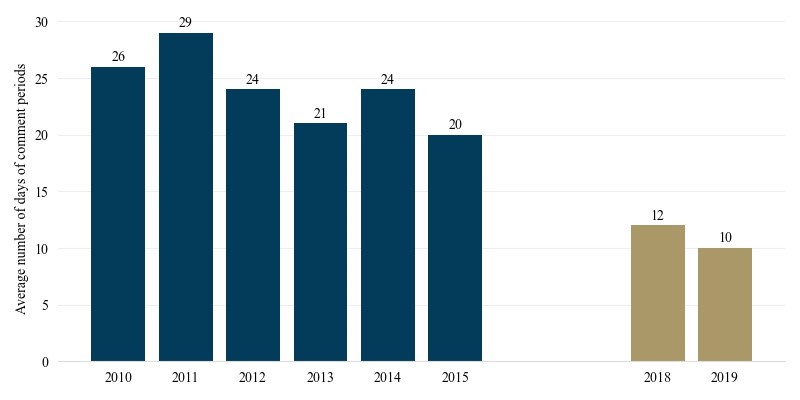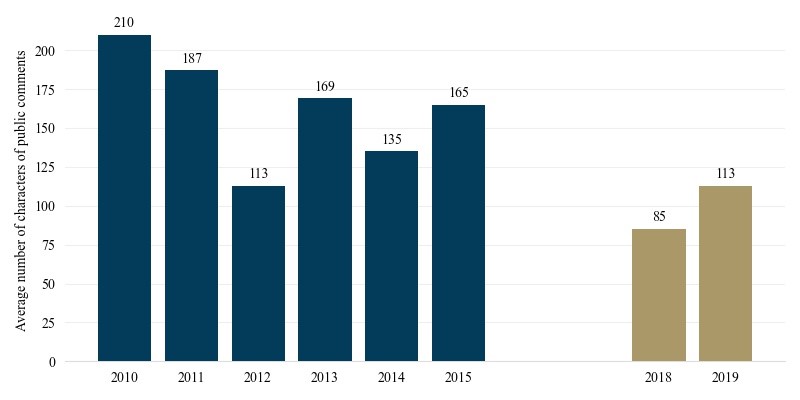Download this Commentary (PDF)
In brief...
The Guangzhou municipal government has been in the vanguard of the implementation of notice and comment policymaking in China. After a decade since its initiation, how is this policy innovation being implemented today? This commentary examines how the notice and comment process in Guangzhou has changed in terms of the frequency of consultations, duration of comment periods, volume of comments, and level of detail of comments.
Introduction
While the notice and comment process for rulemaking has been standard practice in the U.S. for a long time, it is a recent policymaking innovation that appeared a couple of decades ago in China. Our 2020 paper investigates the notice and comment practices implemented by Chinese government organizations and demonstrates that these practices have advanced transparency but have not consistently enhanced public participation in the policymaking process.
One of the government organizations examined in our study is Guangzhou, a municipal government that has been in the vanguard of the implementation of notice and comment policymaking. The Guangzhou government published its first policy consultation and solicited public feedback in 2010, before many other government organizations in China began conducting such practices. Our 2020 paper shows that, during the initial years of implementation, the Guangzhou government regularly conducted policy consultations over time and across policy areas. After a decade since its initiation, how is the policy innovation being implemented today? Did the government sustain its momentum for implementing best practices in China, or did it abandon this policy innovation? Studying these questions may shed light on whether transparency and participation have advanced or regressed under the leadership of President Xi Jinping.
This commentary investigates these questions using a new data set of notice and comment practices. Our 2020 paper analyzes an original dataset covering hundreds of policies proposed by the Guangzhou government and thousands of comments submitted in response to these policies through the beginning of 2016. To track how the notice and comment process has developed since then, we collected a new dataset that consists of policy consultations and public comments occurring in 2018 and 2019.[1] By comparing the 2010-2015 data from our previous study and the new 2018-2019 data, we examine how the notice and comment process has changed in terms of the frequency of consultations, duration of comment periods, volume of comments, and level of detail of comments.
Frequency of consultations
The Guangzhou government began notice and comment policymaking in April 2010 and conducted four consultations during the initial year. During the 2011-2015 period, it sought for public feedback for another 130 policies, with an average of 26 consultations per year (Figure 1). In 2018, the government maintained the previous frequency of consultations by publishing 31 policies for public feedback. The number increased substantially to 51 consultations in 2019, indicating possible diffusion of notice and comment policymaking.
Figure 1: Frequency of Consultations by Year
Duration of comment periods
While the Guangzhou government conducted policy consultations more frequently during recent years, the duration of comment periods decreased significantly. For the consultations conducted between 2010 and 2015, the average duration of comment periods is 24 days, with a minimum of seven days and a maximum of 35 days. The most common duration for comment periods is 30 days, and two thirds of comment periods lasted for 25 days or longer. The annual average duration also remained stable over those years (Figure 2). In our 2020 paper, we point out that comment periods of such durations conform with the central government’s recommendation of 30 days for comment period.
However, the 82 consultations implemented in 2018 and 2019 offered only a 10-day comment period on average. The shortest comment period was three days, and over half of the consultations were open for public comments for less than 10 days. The comment periods were even shorter in 2019 than 2018. Nearly two thirds of the comment periods in 2019 were less than 10 days, and only two consultations were open for public comment for more than 15 days. The substantially shorter comment periods compared to the earlier years suggests the possibility that notice and comment policymaking has become a symbolic procedure instead of a substantive reform for seeking public feedback on proposed policies.
Figure 2: Average Duration of Comment Periods by Year
Volume of comments
How did the shortened comment periods affect public participation? Of the 79 consultations with available public feedback during the 2010-2015 period, the average number was 115 comments. The average is largely driven by a few proposed policies that generated unusually large numbers of comments. The largest volume—4,807 comments—was submitted in 2014 for a proposal related to after-school programs in elementary schools. Excluding this extreme case, the average number becomes 55 comments per consultation. This low figure is driven by the fact that 46 percent of the consultations received three or fewer comments, and 71 percent of the consultations received no more than 10 comments. These volumes indicate a limited level of public participation in Guangzhou’s policy consultations.
The level of public participation did not increase in 2018 and 2019. The average number of comments submitted for the 82 consultations is 62 comments, a 46 percent decrease from the previous average. There was also one policy in 2019 that generated a particularly large number of comments—4,310 comments related to the recruitment of science and technology experts. Excluding this consultation, the average volume of public feedback per consultation is 10 comments, with 44 out of the 82 consultations (54 percent) generating three or fewer comments, and 76 percent receiving no more than 10 comments. Compared to the 2010-2015 consultations, the consultations implemented in 2018 and 2019 generally received fewer comments. While the decreased volume of public feedback could be attributable to various reasons, the shortened comment periods may be one factor underlying this decrease.
Level of detail of comments
Our published study finds that public comments are typically short in length and, therefore, do not provide detailed feedback on Guangzhou’s policies. For the available 9,044 comments submitted for the 2010-2015 consultations, the average length is 134 Chinese characters, equivalent to 87 English words.[2] The shortest comment contains only two characters, and the longest is 1,152 characters. Nearly half of the comments contain less than 100 characters.
For the 2018-2019 consultations, full texts are available for 700 comments associated with 78 proposed policies.[3] The average length of comments is 99 characters. While the longest comment also contains over 1,100 characters, 71 percent of the comments examined contain less than 100 characters. In general, the comments submitted during 2018-2019 are shorter than the 2010-2015 comments (Figure 3).
Figure 3: Average Length of Public Comments by Year
Conclusion
As the vanguard of the policymaking innovation implementing the notice and comment process among the municipal governments in China, Guangzhou continued conducting consultations and seeking public feedback on its proposed policies during the past few years. While it implemented policy consultations more frequently in recent years, it offered significantly shorter comment periods in 2018 and 2019 compared to the first few years of implementing such consultations. Meanwhile, the volume of comments submitted per consultation has substantially declined, and comments have become even shorter in length. This may suggest that the shortened duration of comment periods resulted in decreased opportunities for the public to submit feedback on proposed policies.
Overall, these findings demonstrate lower utilization of the notice and comment process in advancing transparency and participation in policymaking by the Guangzhou municipal government in recent years. What about other government organizations in China? Do similar trends hold across levels of government, policy areas, and regions? Interested readers should check our latest working paper, which examines the durability of the notice and comment process across dozens of central government ministries and provincial governments.
[1] When we collected data in the summer of 2020, the consultation and comment data prior to 2018 had been removed from the Guangzhou government website. Also, the dataset used in our 2020 paper covers data through February 2016. Therefore, we focus on a comparison of notice and comment practices between the 2010-2015 period and the 2018-2019 period.
[2] We assume a ratio of 1,000 Chinese characters to 650 English words.
[3] Full texts of comments are not available for four consultations, including the consultation with 4,310 comments, for which the government only summarized the major opinions expressed in the comments. The other comments are unavailable either because the data were not accessible at the time of data collection or because the government did not publish the full texts of all comments.




